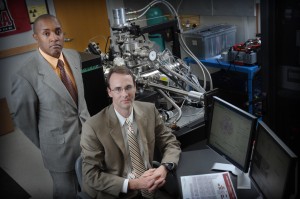
TUSCALOOSA, Ala. — More than 180 scientists from 12 countries who research materials at the atomic scale will soon be on campus in what organizers said is a strong statement on the growing research reputation of The University of Alabama and its College of Engineering.
Held every two years, the International Field Emission Symposium, as the conference is called, was last in Sydney, Australia, and, before that, in Rouen, France. On May 20, colleagues in this specialized science will convene in Alabama for a week-long conference.
Dr. Gregory Thompson, an associate professor in the department of metallurgical and materials engineering, chaired the effort to organize the conference along with Dr. Mark Weaver, professor of metallurgical and materials engineering, and Rich Martens, manager of UA’s Central Analytical Facility. Staff from the College of Engineering, Central Analytical Facility and the Bryant Conference Center also helped organize the conference.
“We are hosting the premier meeting in field emission and atom probe microscopy,” Thompson said. “This conference brings together leading scientists around the world to our campus for in-depth scientific discussions. It speaks volumes on the direction The University of Alabama research is heading.”
UA’s work in nanoscience and nanotechnology, the field of studying and manipulating materials that can be 1,000 times smaller than a human hair, got a boost several years ago when more than $3 million in equipment upgrades were made in the Central Analytical Facility, a UA lab, with the help of federal grants.
Among the upgrades was the Local Electron Atom Probe, or LEAP, essentially a powerful microscope that shows researchers the location and distribution of atoms in various materials. The LEAP’s introduction to science in 2003 provided a renaissance in the atom probe field by allowing millions of atoms to be collected in minutes, rather than hours as done with older generation microscopes.
In 2007, UA became the fourth university in the United States with a LEAP, and although more universities have them today, UA is still the only university in the Southeast with this technology on campus. Scientists from around the nation have come to UA to use the atom probe, including researchers from the Massachusetts Institute of Technology along with the universities of Michigan and Florida as well as local Alabama industries.
Thompson, Weaver and other UA faculty have used the LEAP to understand the chemical structure of materials in hopes to better design materials with tailored properties for such applications as transistors used in cell phones, hard drives for computers, or develop new high strength, low-weight steels used for fuel efficient automobiles.
“The University has and continues to support atom probe research,” Thompson said. “Without this support and the faculty that use this tool in their own efforts, we would not be in a position to host such a premiere meeting. IFES is one of the longest held meetings in microscopy, and we are honored to have been selected to organize such a meeting for our peers.”
A large contingent of the scientists and academics coming to the University for the conference use atom probes for similar research while others work with the scientific concepts that power the atom probe microscope. They are all members of the International Field Emission Society that was founded by Erwin Wilhelm Müller, a German physicist at Pennsylvania State University.
Müller and his doctoral student, Kanwar Bahadur, made history by being the first people to image individual atoms using a field emission microscope. The science learned from their experiments led to the development of the atom probe microscope.
Most of the attendees will stay in vacant UA residence halls during the conference and attend conference sessions in Shelby Hall.
“They can literally immerse themselves in the University’s campus,” Thompson said. “It’s an opportunity to showcase the University’s teaching and research faciltiies and activities.”
Besides buses to ferry the scientists to dinner or shopping each night, there is an excursion Thursday to the U.S. Space and Rocket Center in Huntsville, followed by an award’s banquet at the Davidson Center for Space Exploration. The conference kicks off with an evening reception Sunday, May 20 at the University Club, and the technical proceedings begin Monday and conclude Friday, May 25. More than 180 technical presentations will be given during the conference.
More information about the conference can be found at www.ifes2012.ua.edu.
In 1837, The University of Alabama became one of the first five universities in the nation to offer engineering classes. Today, UA’s fully accredited College of Engineering has more than 3,300 students and more than 100 faculty. In the last eight years, students in the College have been named USA Today All-USA College Academic Team members, Goldwater, Hollings, Portz and Truman scholars.
Contact
Adam Jones, engineering public relations, 205/348-6444, acjones12@eng.ua.edu
Source
Dr. Gregory Thompson, gthompson@eng.ua.edu, 205/348-1589